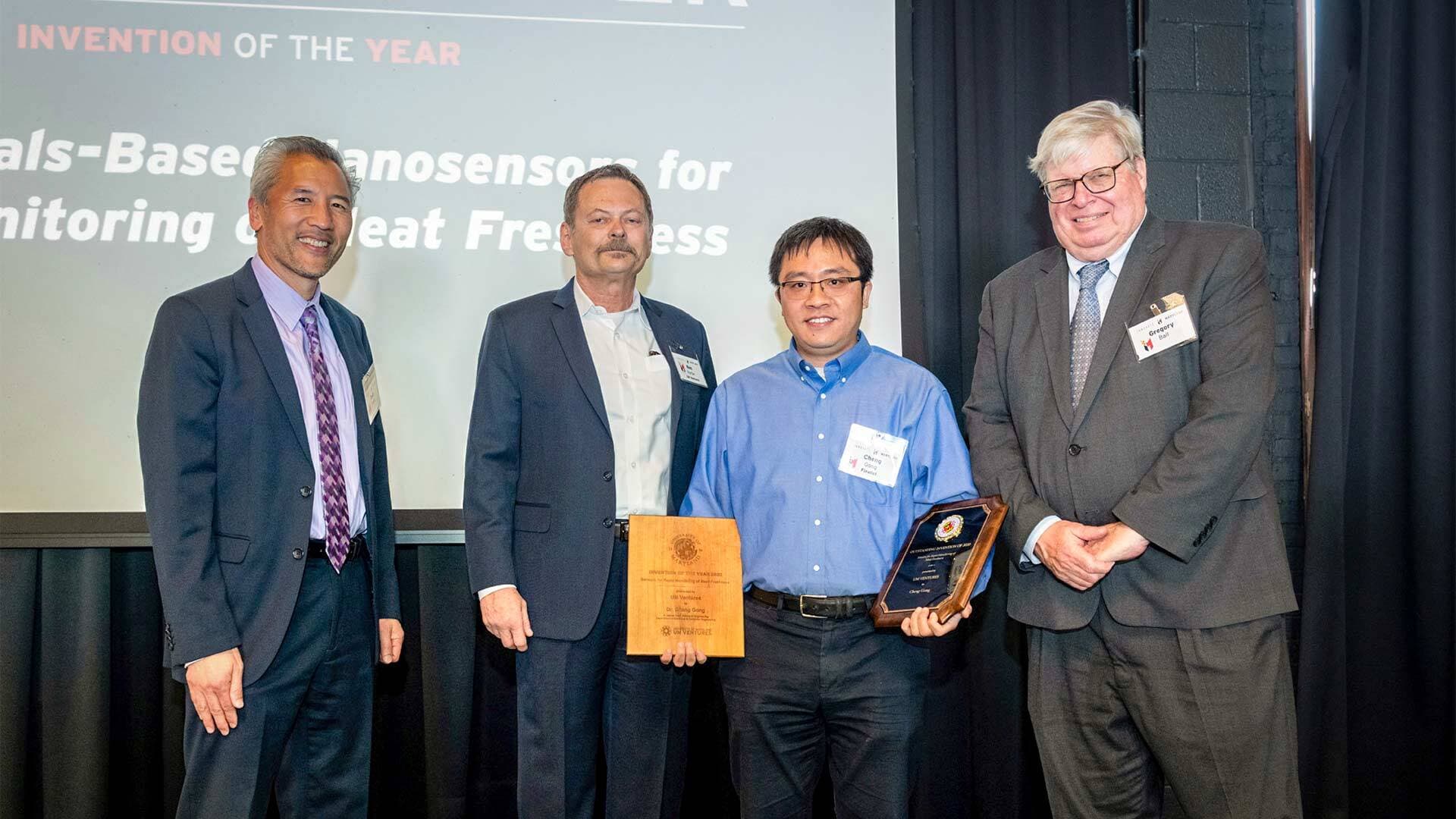At Innovate Maryland, Pines Heralds Turning ‘Expertise Into Action’
From Landmine Danger to Food Security, UMD Inventions of the Year Tackle Grand Challenges

From left, Academy for Innovation and Entrepreneurship founder and UMD Interim Chief Innovation Officer Dean Chang; UM Ventures, College Park Director Ken Porter; Invention of the Year winner Assistant Professor Cheng Gong; and Vice President for Research Gregory F. Ball celebrate Tuesday at Innovate Maryland.
Photo by Mike Morgan
The “use-by” date may have just expired.
A sensor made from a futuristic quantum material that can monitor food freshness to help grocery stores and production facilities slash waste—keeping food supplies safe, abundant and affordable—won the top prize today in the University of Maryland’s annual Invention of the Year competition.
Along with other category winners, it was announced at Innovate Maryland, a yearly celebration of UMD’s growing penchant for turning intriguing bench science into creative and exciting real-world products.
“They all demonstrate how the search for knowledge can spark an idea or an invention that, in turn, can inspire change, improve lives and benefit humanity overall,” Vice President for Research Gregory F. Ball said of the 13 finalists.
UMD inventiveness is never limited to the classroom or the lab, President Darryll J. Pines said.
“What we dream up, engineer and build on campus will have an impact far beyond its borders and will be an example of what a modern public research institution can achieve,” he said. “Translating our expertise into action is a necessary step in advancing the common good, investing in people and communities, and taking on humanity’s grand challenges. From public health and racial injustice to climate change, refugee migration and threats to civic engagement, no problem is truly unsolvable.”
Here are this year’s winners:
Overall Physical Sciences Invention of the Year: 2D Materials-Based Nanosensors for Rapid Monitoring of Meat Freshness
Some 30-40% of the U.S. food supply goes bad, is ruined in production or is simply thrown out before it ever reaches a table, according to a U.S. Department of Agriculture estimate. To rein in that shameful statistic and bolster the nation’s food security, the federal government aims to cut food waste in half by 2030—and a University of Maryland researcher’s innovative sensor system could be a big part of the plan.
Cheng Gong, assistant professor in the Department of Electrical and Computer Engineering at the A. James Clark School of Engineering, developed technology to allow stores, warehouses, and other users to accurately determine the freshness of meat. His tool is based on graphene, a two-dimensional quantum material that’s a single layer of carbon atoms thick. In his sensor, it helps determine the presence of specific gas emissions from meat degradation.
“In the early stages of spoilage, meat produces an odor,” says Gong. “That odor can be ‘smelled’ by our nanosensors.”
This new sensor system surpasses arbitrary “use-by” and expiration dates in providing useful information, while being both cheap and effective; it also promises to be useful for applications beyond just meat.
Gong’s research is supported in part by the Maryland Innovation Initiative, and has been published in Applied Physics Letters and ACS Sustainable Chemistry & Engineering.
COVID-19 Research Invention of the Year: Mucosal Vaccination Against 2019-nCoV Infection and Other Infections
With over half the worldwide population fully vaccinated against COVID-19, an onslaught of breakthrough infections have left scientists wondering what more can be done. Researchers at the University of Maryland are seeking to fill in the gaps left by standard intramuscular vaccines and stop the spread of COVID-19 at its source–in the nose.
Professor Xiaoping Zhu, Assistant Research Professor Weizhong Li, and Faculty Assistant Tao Wang, all of the Department of Veterinary Medicine at the Virginia-Maryland College of Veterinary Medicine and the College of Agriculture and Natural Resources at UMD, have developed a nasal protein vaccination strategy to block viral shedding and transmission from person to person. And because it is protein-based an non-invasive, it can be administered to all ages, either as a primary vaccination or as a booster for those previously vaccinated or infected.
Information Sciences Invention of the Year: Vehicle-Based Anomaly Detection Using Artificial Intelligence and Combined Environmental and Geophysical Sensor Data
Worldwide, 110 million buried landmines and other explosive remnants of war result in an annual 10,000 deaths and injuries. Meanwhile, in the U.S. alone, 7,000 casualties each year result from inaccurate maps used for utility digs. To help prevent these kinds of tragedies, UMD researchers are developing a robust, reliable system to map buried features.that can outperform any current technology.
Physics Professor Daniel Lathrop, geology Associate Professor Vedran Lekić and doctoral student Heidi Myers are working on a cost-efficient, easily deployed, terrain independent, and automated approach to mapping geophysical anomalies by coupling geophysical and environmental remote sensing with unmanned aerial or ground-based vehicles. Sensors include ground-penetrating radar, forward-looking infrared cameras, LIDAR and a novel fluxgate magnetic gradiometer.
Life Sciences Invention of the Year: Suture-free Repair for Surgery, Cuts and Wounds
Up to 10% of surgeries to repair and connect tubular tissues such as arteries or intestines fail because of badly-sewn sutures or fragile body tissues. University of Maryland researchers have developed a method streamline the suturing process and move it beyond traditional needle and thread with a biocompatible polymer gel that can be spread across tissues and caused to adhere strongly using about 10 volts of DC current, slightly more than that from a standard 9-volt battery.
Developed by chemical and biomolecular engineering Professor Srinivasa Raghavan and Leah K. Borden Ph.D. ’22, the gel also works for punctures and tears and is comparable to well-done sutures in strength, and meanwhile can be easily caused to release from living tissue by applying another current—a potential game changer for future surgeries.
Read the full list of finalists in every category.